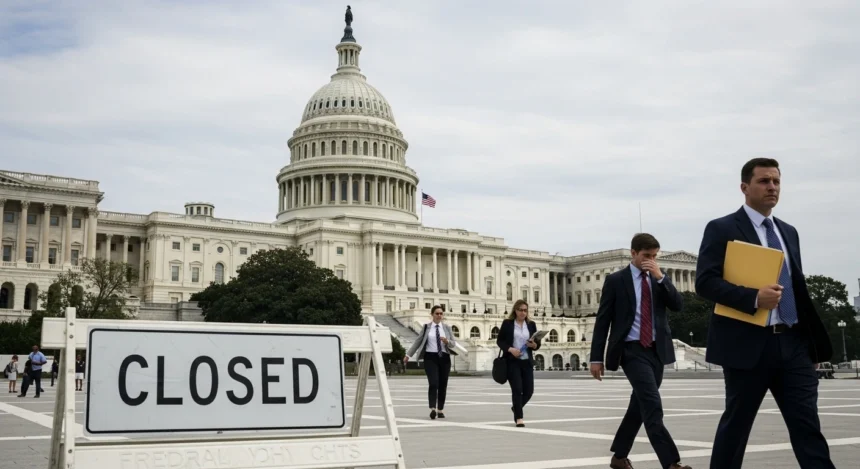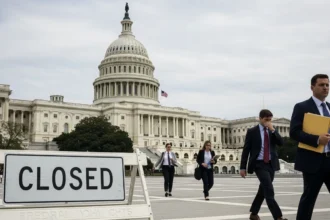The United States officially entered a government shutdown on October 1, 2025, after lawmakers failed to agree on funding measures. Unlike past budget fights, this standoff is wrapped up in debates over healthcare subsidies and long-term spending priorities, making a quick resolution less certain.
While short shutdowns are inconvenient, a prolonged one in 2025 could prove far more damaging. With U.S. economic growth already under pressure from higher interest rates, household debt, and uneven job gains, even a few weeks of stalled government operations could ripple through every corner of the economy.
What Counts as “Prolonged” and Why It Matters
Economists often define a prolonged shutdown as one lasting more than two to three weeks. Every week the government stays closed, experts estimate the U.S. economy loses roughly 0.1 percentage point of quarterly GDP growth, or about $7 billion in activity. Some forecasts go higher, suggesting losses could climb toward $15 billion per week if the impasse drags on.
History offers a warning. The 2018–2019 shutdown, which stretched to 35 days, cost the economy $11 billion, including $3 billion in permanent losses that were never recovered. The difference in 2025 is that growth is already more fragile, which means the pain could arrive faster and last longer.
How Shutdowns Hurt the Economy
- Direct loss of output
- Hundreds of thousands of federal workers are furloughed.
- Agencies pause contracts, procurement, and services.
- This directly reduces government spending and economic activity.
- Spillover into the private sector
- Federal contractors and suppliers face payment delays.
- Small businesses waiting for SBA loans or federal grants can’t move forward.
- Delays in permits, licenses, and certifications choke private-sector investment.
- The data blackout problem
- Agencies like the Bureau of Labor Statistics and the Bureau of Economic Analysis suspend or delay reports.
- Key indicators such as employment, inflation, and GDP updates won’t be published on time.
- Without reliable data, the Federal Reserve may struggle to set interest rate policy, creating more market volatility.
The Human Impact: Workers, Households, and Communities
- Federal employees: Roughly 750,000 workers have been furloughed, while others are working without pay. Back pay is typical for direct employees, but many contractors never recover their lost wages.
- Household stress: Missed paychecks lead to reduced consumer spending, late bill payments, and increased reliance on credit cards. This effect builds week by week.
- Unemployment distortions: If the shutdown overlaps with government survey weeks, the jobless rate could appear artificially higher, further shaking confidence.
- Local economies: Communities near national parks, museums, and federal offices see a sharp drop in tourism and local spending.
Key Sectors at Risk
- Healthcare
- At the heart of this shutdown is a fight over Affordable Care Act premium tax credits. If subsidies lapse, millions could face higher premiums, and insurers may raise rates in anticipation.
- Small businesses & startups
- SBA loans, research grants, and federal contracts are on hold. For many small firms, even a short delay can mean layoffs or closures.
- Travel and tourism
- National parks and federally run attractions are closing or operating with skeleton crews. This directly hurts nearby restaurants, hotels, and service providers.
- State and local governments
- While short disruptions can be managed, longer ones cause cash flow delays and could impact credit ratings for certain states and municipalities.
- Financial markets
- Regulators like the SEC and CFTC are partially shut down, delaying IPO approvals and regulatory oversight. Markets typically look past short closures, but if it drags, volatility spikes.
Best- and Worst-Case Scenarios
| Scenario | Duration | GDP Impact | Economic Features |
|---|---|---|---|
| Short shutdown | 2–3 weeks | -0.2 to -0.3 percentage points | Most activity recovers in the next quarter |
| Prolonged shutdown | 5–8 weeks | 0.5+ percentage point hit | Higher unemployment, permanent losses, household stress |
| Policy breakthrough | Early deal tied to ACA credits | Minimal | Quick rebound in confidence and spending |
The longer the shutdown, the less likely the economy fully bounces back. Businesses don’t always restart canceled investments, and households can’t instantly replenish lost savings.
What to Watch in October 2025
- Congressional negotiations—whether leaders move toward a continuing resolution or remain stuck.
- Alternative data—private payroll and spending trackers filling the gap left by missing federal reports.
- Healthcare developments—insurer guidance as ACA subsidy uncertainty looms.
- Federal Reserve meetings—how the Fed interprets economic conditions without official data.
- Consumer and business sentiment surveys—sharp declines here could signal broader weakness.
Why This Shutdown Is Different
The U.S. economy has endured shutdowns before, but the 2025 version carries more risks. Growth is weaker, household budgets are stretched, and policymakers are operating with fewer reliable data points. Every additional week of closure raises the chances of lasting damage—from higher insurance premiums to reduced small-business survival rates.
A short shutdown may only be a bump in the road. A prolonged one, however, could leave lasting scars on the economy, household confidence, and America’s global credibility.









